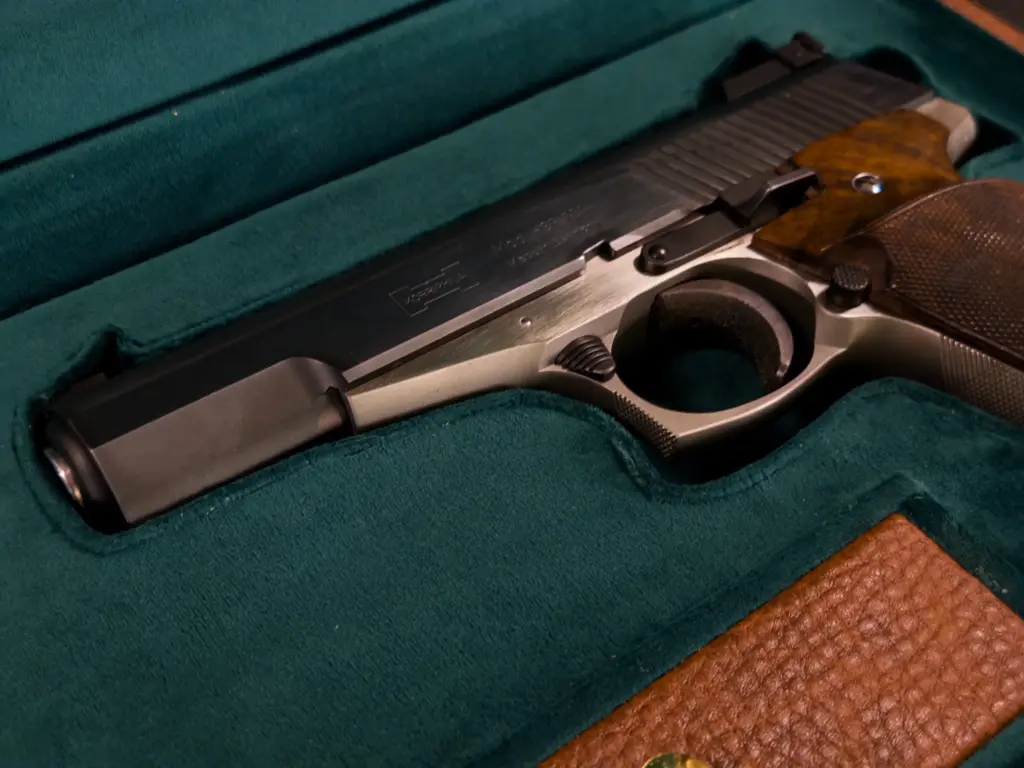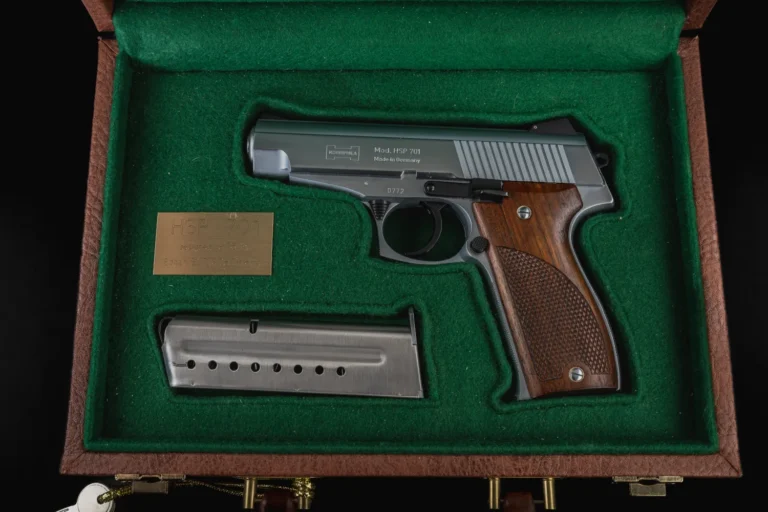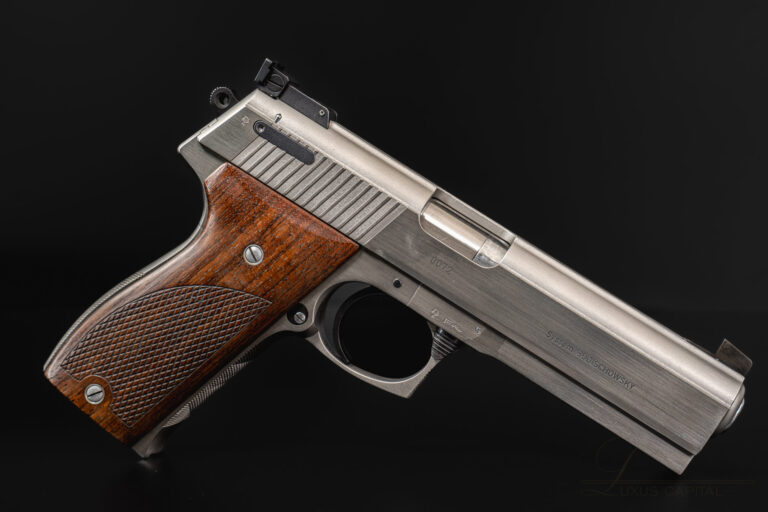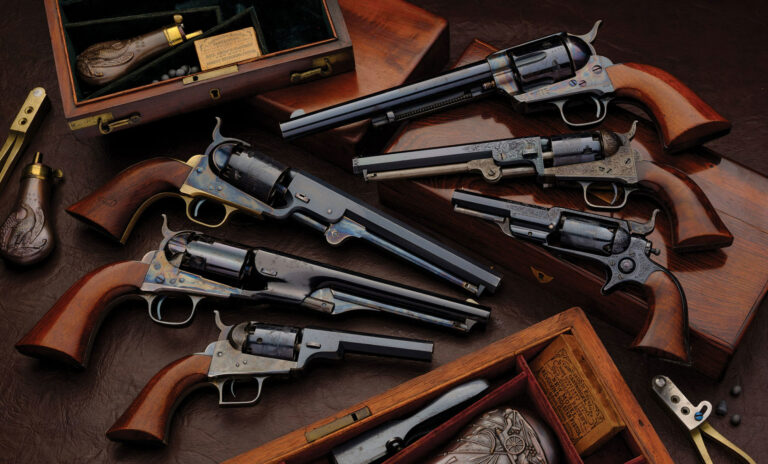Key Takeaways:
- Korriphila firearms aren’t mass-produced—they’re hand-crafted, low-production masterpieces born from one man’s obsession with precision.
- Edgar Budischowsky didn’t build guns for the market. He built them for the few who notice when things are done exactly right.
- The HSP-701 is a legend for a reason.
- With its rotating barrel, delayed blowback system, and .45 ACP chambering, it’s a perfect storm of performance, elegance, and mechanical innovation.
- Owning a Korriphila is like owning a piece of genius—quiet, rare, and built to last.
- These aren’t just collectibles. They’re a legacy you hold in your hand.
Let’s be honest—there’s something about a firearm that’s more than just its function. Sometimes, a gun feels like it’s whispering history. Sometimes, it roars genius. And then there’s Korriphila—where everything slows down, precision matters more than mass production, and each piece feels like it was made just for the person holding it.
You’ve probably heard the name thrown around in the same breath as “engineering marvel” or “Swiss-watch-level quality.” And that’s fair. Korriphila firearms are kind of the horology of the gun world. Mechanical art. Understated brilliance. The kind of thing that makes collectors lean in a little closer.
And at the center of it all? Edgar Budischowsky.
The Man Behind the Machine: Edgar Budischowsky
Some people invent things. Others obsess over every bolt, curve, and moving part until perfection isn’t just a goal—it’s a compulsion. Budischowsky was the second kind.
The guy wasn’t interested in riding trends or cranking out mass-market pieces. He wanted to make firearms that were beautiful, deadly accurate, and built like no one else dared to build them. Korriphila, the company he founded in the late 20th century, was basically his sandbox for that obsession. No flashy marketing. No gimmicks. Just a stubborn commitment to quality.
And it shows.
Budischowsky’s philosophy? Traditional style + cutting-edge mechanics. Old-world aesthetics, but with an almost neurotic precision baked into every mechanism. It wasn’t just about form or function—it was both, fused so tightly together that you couldn’t separate them even if you tried.
Enter the HSP-701: The Unicorn of Precision Pistols
If there’s one gun that sums up Budischowsky’s legacy, it’s the HSP-701. It’s not just rare—it’s borderline mythical.
Released in the 1980s, the HSP-701 didn’t just enter the market. It slid into the room wearing a tailored suit, casually outshooting everything else in its class. It was chambered in .45 ACP—because of course it was. Big, authoritative, but still refined. Like a heavyweight boxer who wears a tuxedo to the weigh-in.
But the real magic? The engineering under the hood.
A delayed blowback system that made recoil feel like a suggestion. A rotating barrel mechanism that tightened up groupings in a way that made other pistols feel like they were lobbing shots in the general direction of the target. It wasn’t just about innovation for the sake of it—it was about pure performance.
And because only a few hundred were ever made, getting your hands on one today? That’s a different kind of hunt altogether.
Why Korriphila Feels Different
Try describing a Korriphila firearm to someone who’s never seen one. “It’s like if a 1911 and a Swiss music box had a baby… but meaner.”
They’re not loud. Not in design, not in branding, not in personality. They don’t scream for attention like some overbuilt tactical pieces. They don’t come dripping in rails or “modular options.” Instead, they hum. Smooth, silent, and self-assured.
Each part feels like it belongs exactly where it is—and nowhere else. The finish is immaculate. The tolerances are so tight you’d think the parts were grown together rather than assembled. And the trigger pulls? Clean, crisp, and oddly satisfying, like snapping a dry twig in a quiet forest.
There’s a reason people compare them to fine watches. The comparison isn’t even about luxury—it’s about obsession. About getting the tiniest things exactly right, even if no one but you will ever notice.
Why Rarity Isn’t Just Hype
Scarcity is weird, right? Sometimes it’s artificial, sometimes it’s marketing fluff. But with Korriphila, the rarity feels earned. Authentic. Almost inevitable.
Budischowsky didn’t believe in volume. He believed in focus. So the production numbers stayed low—painfully low. But that’s what kept the quality high. It’s also what turns every Korriphila piece into a bit of a holy grail for collectors.
When something’s this hard to get, you pay attention. You remember where you saw one last. You talk to other collectors, hoping someone knows a guy who knows a guy.
And when one finally shows up at auction? Prices don’t just climb—they skyrocket. But the real collectors? They don’t care. Because once you’ve been chasing a Korriphila long enough, the price tag becomes just one more part of the story.
Beauty Meets Brains: The Craft Behind the Gun
Here’s where things get even more interesting. A lot of high-end firearms lean heavy into either performance or looks. You rarely get both. But Korriphila? It threads that needle.
Budischowsky had this ability to make guns that were both deadly and elegant. His design ethos blended classical European flair with modern ergonomics. They feel good in your hand. Balanced. Intentional.
The surfaces? Smooth, cold, flawless. The machining? Almost unnervingly clean. You can tell someone spent a long time on every single component, not because they had to, but because they couldn’t sleep at night if they didn’t.
You can see it in the lines. You can feel it in the way the slide glides—not snaps—back into place.
These weren’t just tools. They were statements.
Historical Weight Without the Dust
Korriphila didn’t show up in a vacuum. The firearms world was shifting in the late 20th century. Glocks were making polymer mainstream. Sig Sauer was climbing the tactical ladder. But while everyone else chased trends, Budischowsky built something that felt like it had already existed for a hundred years.
And weirdly enough, that gave Korriphila staying power. These weren’t guns that got overshadowed by the next new thing. They stood still while the rest of the market swirled around them—and somehow, they remained relevant.
Today, collectors don’t just see them as artifacts. They see them as benchmarks. As “how good could this get?” examples of what happens when one man refuses to compromise.
Owning a Korriphila: The Collector’s Paradox
Let’s say you get lucky. You find a Korriphila, the papers check out, the condition is mint, and it’s finally yours.
Now what?
Some collectors display them behind glass. Others shoot them—carefully, lovingly, maybe once a year, just to remember how it feels. Either choice is valid. But both come with this weird paradox: it’s too perfect to leave locked away, but too rare to treat like any other gun.
So you clean it often. You inspect it more than you probably need to. You store it like it’s a crown jewel—because, honestly, it kind of is.
A few tips that help:
- Always verify the provenance. There are fakes out there, and this isn’t the kind of piece you want to guess on.
- Use proper oils and materials—this isn’t the time for generic solvent from a big-box store.
- Climate control matters. Moisture is the enemy of history.
Treat it like a watch, not a wrench. It’ll thank you for it.
Why They Still Matter
A lot of guns age out. What was once cutting-edge becomes outdated. But with Korriphila, the genius is baked into the bones. It doesn’t age—it matures.
Modern collectors still look at the HSP-701 and scratch their heads in admiration. That rotating barrel? That recoil system? It’s still teaching lessons, even decades later.
In fact, plenty of contemporary gunmakers quietly borrow from Budischowsky’s playbook. Whether they admit it or not, the influence is there—in the clean lines, the mechanical solutions, the refusal to slap plastic over something that should be metal.
So yeah, Korriphila’s not just history. It’s a blueprint.
Final Thoughts: The Kind of Thing That Sticks With You
Korriphila isn’t for everyone. That’s not gatekeeping—it’s just truth.
These firearms require patience. Appreciation. A bit of reverence, maybe. They’re not for people looking to fill a safe. They’re for the ones who still pause to admire the machining on a bolt, or who can talk about trigger reset like it’s jazz.
Owning one feels like joining a quiet little club. You’ll meet others, nodding knowingly across the room at some obscure collector event. You’ll share stories, trade tips, maybe even pass on your piece someday to someone who “gets it.”
And when that happens, the legacy continues—not just Budischowsky’s, but yours too.
Frequently Asked Questions
They were produced in extremely limited numbers by Edgar Budischowsky, who prioritized craftsmanship over quantity. Each piece was obsessively engineered, not mass manufactured.
It’s mechanically innovative (rotating barrel, delayed blowback), chambered in .45 ACP, and represents the height of precision handgun design. Plus, very few were made.
Honestly, both. They’re built to perform—and they do—but many collectors treat them like art: something you appreciate, care for, and shoot sparingly.
No, Korriphila is no longer in active production, which only adds to the rarity and mystique surrounding existing pieces.





